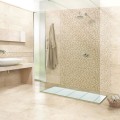Top 10 Granite Tile FAQs

Granite’s one-of-a-kind speckled pattern offers a dynamic look for your space. (Agra Granite Tile – Black Galaxy)
1. What is granite?
Granite is an especially dense type of igneous rock consisting of interlocking minerals such as quartz and mica. Due to granite’s heat-resistant nature, durability, and strong composition, it’s a solid choice for flooring and countertops.
2. What does finished granite tile look like?
Granite tile is popular because of its ornamental coloring and choice of surface finishes. Each type is attractive in appearance and easy to clean. Polished granite is shiny to the point that you can see your reflection in it. Leathered granite has a slight sheen to its surface but offers a more minimalist appearance. It’s quite popular because it hides smudges and water spots well.
Honed granite isn’t ground as much during the manufacturing process, so it’s not shiny or reflective. Some people prefer this due to its subtlety. Brushed granite also lacks sheen. In its place, there’s an aged, antique look to it that fans of classic style prefer.
3. Where can I use granite tile?
Since this natural stone is especially durable, it’s suitable for most settings. Whether your purpose is commercial or residential, high or low traffic, granite tile will perform exceptionally well. Note that each style has its strengths.
- Polished granite: A smart choice for kitchen counters due to its ability to withstand the heat of cooking materials, it’s also suited for wall cladding, vanity tops, and decorative objects due to its lustrous sheen. Finally, it’s great for heavy traffic indoor flooring due to its strong resistance. Leathered granite is great for these applications as well.
- Honed granite: Often used for high traffic commercial flooring due to its durability and lack of shine, it also functions well for sidewalks and other outdoors areas with heavy foot traffic. This finish is also popular for bathroom applications.
- Brushed granite: Along with being used for kitchen counters, this type is great for many outdoor applications, including decks, sidewalks, curb stones, and outdoor furniture.
4. What should I consider before choosing granite tile?
You’ll love granite’s durability, especially the polished style that requires the least frequent amount of resealing. You should also take note of the setting before selecting granite. Granite’s coloring is quite varied and lacks uniformity, which appeals to some but not others. Finally, polished granite can be slippery, so you shouldn’t use it in areas prone to wetness.
5. How is high quality granite produced?
The quality of granite is determined by different steps taken throughout the entire production process. Quality granite is:
- Mined using modern methods
- Cut using water as a coolant to ensure lasting product quality
- Calibrated to ensure uniform thickness, gauged to ensure the tiles are square, and beveled to produce smooth edges on the tiles (product dimensions are controlled according to ASTM standards)
- Inspected at different stages of the manufacturing process; products are segregated for unusual patches, major color variations, cracks, dimensions, surface finishes, and other quality issues.
6. Why should I avoid kerosene cut granite?
Some manufacturers in the industry use petroleum by-products as a coolant to aid the cutting process and reduce costs. When this is done, the granite is soaked in water and washed after being cut to remove the chemical smell, but the damage is done the moment the chemical comes into contact with the ferric content in the stone.
Within a couple years, rust marks will appear on kerosene cut granite. To avoid this damage, choose granite that has been cut with a water coolant (at BuildDirect, we only sell granites cut with a water coolant).
7. Does granite tile stain? How do I prevent it?
Yes, it can stain due to the porous nature of the stone, especially if a spill is not cleaned up quickly. To protect granite from stains and water patches, seal the surface with a water-based penetrating sealer. Depending on how the surface is being used, it can be sealed once a year or once every two years.
To determine if you need to apply sealant, perform the Paper Towel Test. Soak a paper towel and then place it on the granite tile. After five minutes, is the area below discolored? If so, it’s time to re-seal your tile.
8. What should I consider before choosing granite tile?
You should consider your needs and then research the absorption rating and abrasion resistance rating for your favored tile. Also note that some granite tiles are resin-treated to address imperfections in the tile, like micro-fissures, and make the color pop. These tiles are more prone to early discoloration.
9. How much breakage should I expect with an order?
While it’s common to have 2% to 3% of the tile broken to some degree (chipped edges for example), any amount up to 10% is considered acceptable by industry standards. Damages tiles can be used for cuts you’ll need to make during installation. If breakage is above 10%, contact your tile retailer.
10. Can granite tile be butted?
Not only is this possible, but this is the preferred installation method for granite tile floors. With this method, it’s important to make sure the tiles are matched before being set. Once they’re set, it’ll take a lot of effort to detach them.
What other questions do you have about granite tile? Let us know in the comments.
Browse our selection of top quality Granite Tile here.



